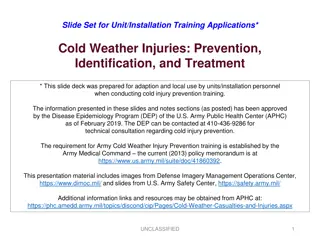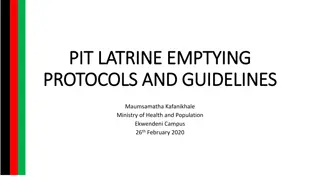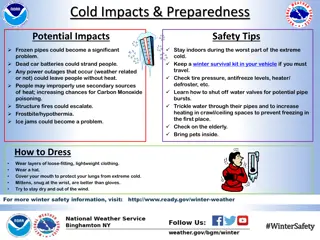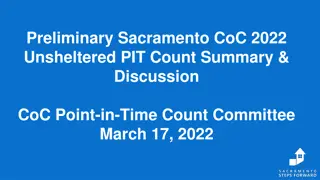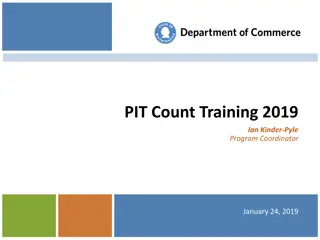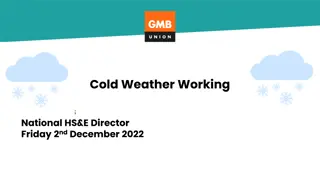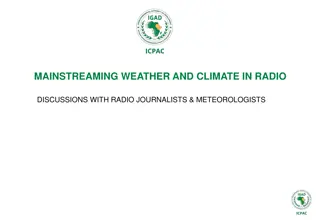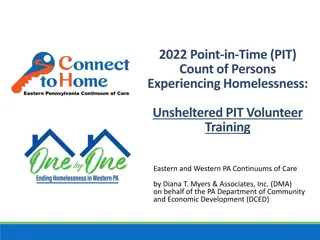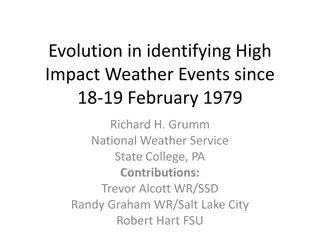Cold Weather Pit Count Coordinator Module 3 Planning for Success
Cold weather presents challenges for conducting pit counts to address homelessness. Visibility of homelessness decreases in cold weather, making locating individuals more challenging. Planning ahead with contingency dates, volunteer coordination, and route planning is crucial for success in cold weather operations. Volunteerism requires appropriate dressing and awareness of signs of exposure. Effective communication and coordination are key in ensuring a successful cold weather pit count.
Download Presentation

Please find below an Image/Link to download the presentation.
The content on the website is provided AS IS for your information and personal use only. It may not be sold, licensed, or shared on other websites without obtaining consent from the author. Download presentation by click this link. If you encounter any issues during the download, it is possible that the publisher has removed the file from their server.
E N D
Presentation Transcript
BRANDON COLD WEATHER PiT COUNT Mark Anderson PiT Count Coordinator Module 3 Planning for Success
Cold Weather Context Cold weather count demonstrates most significant needs. However, cold weather obviously introduces additional challenges.
Cold Weather Context Visible homelessness decreases in cold weather in our context. The warm spots become first priority. For us, this was daytime locations (ie. Downtown area, proximity to services, downtown mall, etc.). Once the warm spots close, locating and identifying becomes more challenging as our populations generally turn towards couch surfing and therefore become more hidden the colder it becomes.
Cold Weather Context For volunteerism, this presented a challenge as we needed more volunteers for daytime shifts than evening shifts.
Cold Weather Planning Watch the forecast, and have a contingency date. We offered two training sessions (daytime or evening option) one week prior to planned date. One week ahead provided enough lead time with forecast to determine if weather was manageable or questionable. Training sessions provide opportunity to discuss contingency date and the likelihood of needing it. Contingency date, if needed, triggered in consultation with planning group.
Cold Weather Planning Have great volunteer contact information in case of notification for a date change. We directed all volunteers to sign up on the website (no phone-in or email registrations). All details were captured from website form into MailChimp. This was useful for general notifications for communication pieces, training times, and rescheduling if it had been needed. It also provides good year-over-year tracking.
Cold Weather Planning Ensure good route planning and warm-up options Given the size of our city, one central organizing location was sufficient for us. Volunteers were instructed to stop in as many times as they wanted to warm up, have a hot drink, etc. All volunteers groupings had a vehicle amongst them to get to and from survey areas. Generally speaking, most areas were walked once there.
Volunteer Planning Tips on cold weather Dressing appropriately for the weather (ie. Layers and windproofing) Watch for signs of exposure (both volunteers and homeless individuals) like white and waxy skin patches, uncontrolled shivering, confusion. Provide Coordinator Contact number for questions Provide instructions on when to call 911 Ensure Police Services are aware of activities, establish a safety plan
Volunteer Planning Shorter shifts to match temperatures We gave the option for 1 or 2 hour shifts based on volunteer preference. Bring backpacks to carry your own extra mitts and toques, as well as participant thank-you s. We worked with local store and their suppliers to offer high quality socks and toques, plus a coffee card.
Volunteer Planning Miscellaneous Items Try for mitten friendly and cold friendly supplies Sharpies, not pens (ink freezes) Clipboards for completed and blank forms Flashlights (dark early) Discuss sheltered areas vs. sight lines in safety plan (to try and get out of the wind while surveying)
Additional Information Bnrc.ca brandonhousingfirst.ca survey.brandonhousingfirst.ca Mark Anderson mark@gipit.ca



